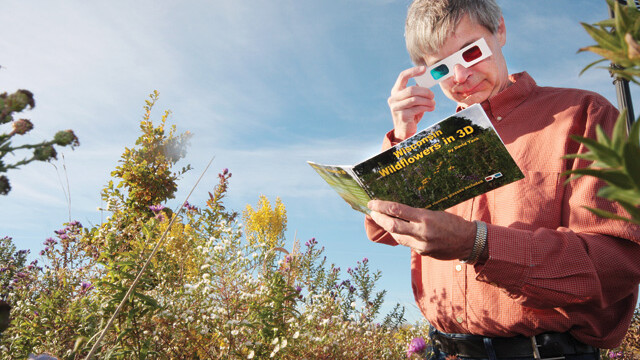Pop Go the Flowers
local author releases photo book of wildflowers in 3D
Bailey Berg, photos by Andrea Paulseth |

The 3D market is exploding. After the success of Avatar, filmmaking in 3D has practically become the norm. The technology is now also used in video games and television shows. Heck, even high-end spectacle makers are releasing fashion-forward (hipster) versions of the old cardboard 3D viewers in sunglasses form. And with UW-Stout professor David Tank’s newest project, Wisconsin Wildflowers in 3D, the phenomenon is expanding to books.
I had some kids who ... were reaching out trying to touch the flowers, their fingers two inches from the page. ... It’s kind of fun to watch.
Wildflowers is not just another field guide to Wisconsin’s flora and fauna; it’s like nothing we’ve ever seen before. The book contains 108 photographs, each including the plant’s common name, height, bloom time, and habitat, as well as interesting tidbits of information about many of the plants. Roughly organized by bloom time – starting with Wild Geranium and ending with Dotted Horsemint, the book includes flowers ranging from Catnip and dandelions to Queen Anne’s-lace, Labrador tea, and Pink Lady’s-slipper. All in 3D.
The real magic of the book is in the glasses. When viewed through the 3D specs, you feel like you’re standing in a meadow, looking down at brilliant blue Wild Morning Glorys. There’s just an unreal amount of depth to every image, which tricks your mind into thinking you’re actually there, and that you could reach out and feel the texture of the plant.
Tank has spent the last 20 years working with 3D photography, making old-fashioned stereo viewer cards, using two pictures strategically taken so they appear to pop off the page.
“I always thought it would be nice to be able to publish my pictures,” Tank said. The problem was most people don’t have an old stereoscope lying around the house. Fortunately, after some experimenting, digital photography and printing came to the rescue, allowing him to create 3D images that could be viewed with a pair of red and blue 3D glasses. Wildflowers proved to be a gargantuan undertaking. “I started as soon as the wildflowers came up this spring,” Tank said. “Over the summer I shot about 14,000 pictures.” In a few months time, Tank traveled all over Wisconsin, shooting pictures of the state’s flora by day, and working to convert them into 3D images by night. “I had to make sure that they actually worked,” Tank explained. “If they didn’t I’d have to go back the very next day to re-shoot, because wildflowers don’t last very long, and if I didn’t get one right, but came back a week later, it might be gone.”

Tank isn’t new to the publishing world. In 2008 he published his first book, River of Hope, a book discussing his wife’s battle with Lou Gehrig’s disease. Wildflowers presented some other obstacles.
“One challenge of producing a book like this is finding a printer who will work with you and has the ability to print the high-resolution images digitally. Fortunately, I was able to get the quality I needed by working with Eau Claire Printing,” Tank said. “It was great to be able to keep it local.”
Copies of the book are available on Amazon and 3Dwildflowers.com. Tank will also host a presentation on the book and 3D photography in general at the Russell J Rassbach Heritage Museum on Nov. 14 at 1:30pm, presented by Dunn County Historical Society.


















